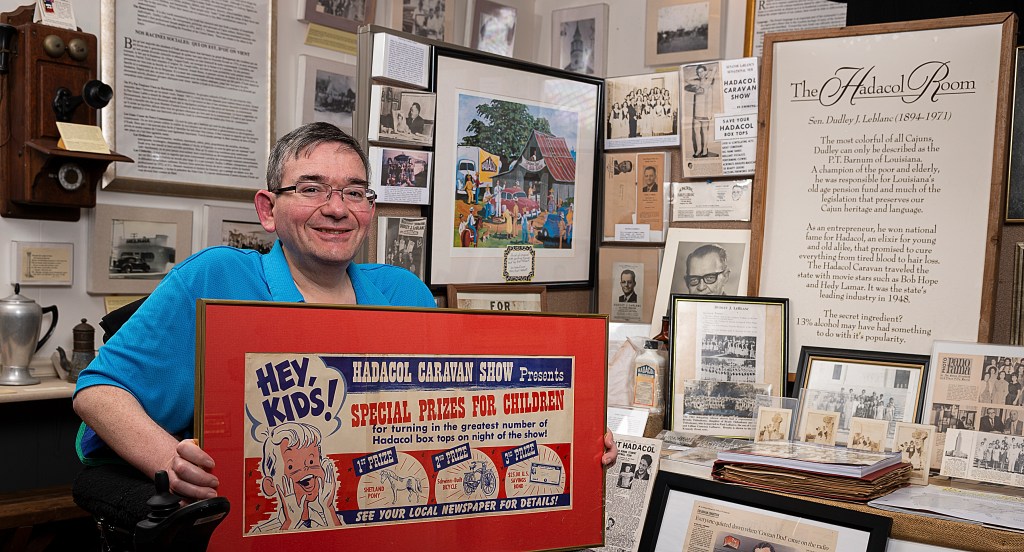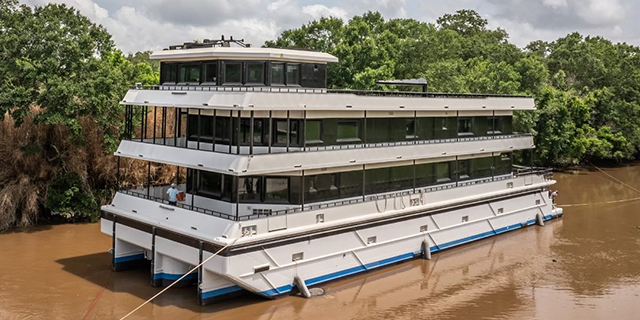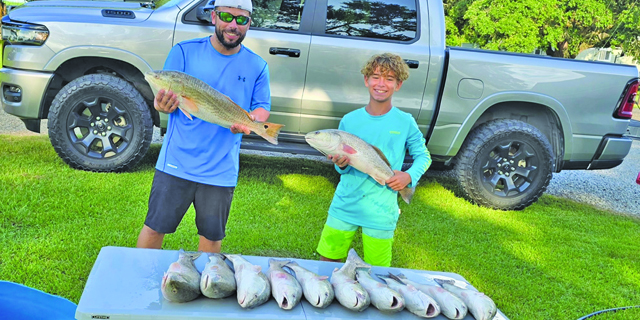Robert Vincent’s life of triumph
Published 7:00 am Wednesday, January 15, 2020

- Robert Vincent with some of his Hadacol collectibles he donated to the Erath Museum.
This story comes at the perfect time – the beginning of a new year, when resolutions are proclaimed but, according to research, fewer than 20 percent of them kept. It’s an inspirational story, for sure, about using what you’ve been given to the best of your ability, of living for today only, and of grace in the face of debilitation.
After several falls during a family camping trip, a 10-year-old Robert Vincent was taken to a Gettysburg doctor who noticed the boy’s feet turned inwards and strongly suggested that he see a specialist when they return home. Several tests later, Robert found himself sitting across a doctor’s desk with his mother, hearing that he had a degenerative nerve disease known as Charcot-Marie-Tooth Disorder (CMT). Having nothing to do with teeth, it is named after the three physicians who first identified it. The disorder damages the nerves in the arms and legs and is most often inherited – except in Robert’s case. He is one of an estimated two in 2,000 people who contracted CMT with no family history. Genetic testing performed by Baylor University found no inherit trace – a fact that didn’t make the disease more forgiving.
Trending
A year after the diagnosis, Robert’s feet began turning inward so rapidly that he required three surgeries in three months to correct them. That allowed him to continue walking and he grabbed the opportunity and ran with it. “I climbed ladders, rode my bike around town, and did things any normal kid would do,” Robert remembers. Over the span of 30 years, he continued walking through middle school, to college, and eventually on stage to accept his law degree.
No doubt, Robert has had to learn to adapt to continuously changing limitations. He has redirected his energy and focus to just being Robert — and not a disability. While he doesn’t have much stamina, his psyche has never quite caught on to that fact.
“It was my life as it was,” says the Erath native of his diagnosis and prognosis. “I asked myself early on, ‘With this disability, what can I accomplish?’ I was never going to be a sports star, but there were so many other things I could accomplish.”
It was no surprise to his parents when in 1999, at the age of 19, he was elected as an Erath city councilman and, as mayor pro tempore, the youngest elected official in the state at the time. He kicked off his term immersing himself in planning Erath’s centennial celebration that year. Over the course of his four-year term, he co-founded the Acadian Museum of Erath with attorney and cultural preservationist Warren Perrin – who is also Robert’s uncle. When the Hwy. 14 bypass opened, Robert’s efforts helped incorporate land into the town. He also successfully campaigned to bring Erath a water treatment system. And, when the town’s patriotism really shines on the Fourth of July, many tip their hats to Robert, the longest serving president of the holiday’s association.
After losing re-election into the council by only 50 votes, he pushed forward pursuing a Masters of Business Administration degree, which he accomplished in 18 months. In 2006, he was accepted in Southern University’s night school program, graduating in 2010; he passed the bar exam and was sworn in that same year. From 2011 to 2014, Robert was prosecutor for Erath. In 2014, he ran again for the council seat and won.
That year brought victory and defeat, when the disease that normally travels upwards and stops at the knees and elbows left Robert’s feet, legs and thighs atrophied and his fingers curved down like a swan’s neck, preventing him from picking up a pen. The disease then took an unexpected turn and began invading his diaphragm so that he couldn’t breathe on his own. Back in 2014, doctors in Acadiana had seen only one other patient whose CMT had affected their diaphragm.
Trending
Since then, Robert has required breathing assistance from a BiPAP machine, which pushes 30 pounds of oxygen to lift his lungs. Now 41 years old, he sits in the wheelchair that he was told years ago to purchase for when the day would come that he’d need it without warning. But then, he was also told he had an estimated three months to live. Not only did he outlive that prediction, he was re-elected to the council last year.
Today, his law practice is limited to serving in an advisory capacity. Living with his parents, he leaves the house only to attend his monthly council meeting and church services with his mother every weekend in nearby Henry. Either excursion can wipe out his stamina leaving him with the choice to eat – or breathe.
“On my worst day I’ll experience a shortness of breath that leaves me gasping for air even with the BiPAP machine,” he says through the oxygen mask on his face. “It feels like I’m underwater for a long time and when I finally come up, I’m desperately struggling for that first breath.”
Robert has learned to deal with adversity as it comes and not allow CMT to get the best of him. For most, that would be a feat in itself, but he has many proud accomplishments to look back on. “I helped raise $160,000 for the building of an all-weather track at Erath High. (His mother proudly interjects, “He couldn’t run on a track, but he helped build one.”) With a smile of appreciation, he continues, “Being involved with the building and continuation of the museum has meant a lot to me. Through Warren, myself and others, we’ve saved the history of the town – and, consequently, its culture. The Fourth of July celebration has been close to my heart; it started in 1936 and is an event loved by the residents. The money we’ve raised has done great things for the community.”
Most recently, Robert was notified by Southern University Law Center that he is being honored with the Distinguished Alumni award at a ceremony that will be held in April, 2020. That was a great day.
And on the not-so-great days, he still reminds himself that “God has blessed my life and given me so many opportunities and skills to help others, why would I complain about that?”
As for future projects, Robert is promoting an entrance for Lahasky Memorial Park with a plaque of its history. “The property is adjacent to the site of the former Erath General Hospital, first opened by Dr. Bernard Lahasky,” he explains. “Dr. Lahasky provided so much free medical care to residents and also started businesses in Erath. I’m also working on getting a marker in downtown Erath to designate the site where the water tower fell during Hurricane Hilda in 1964, killing eight civil defense workers who were in the office beneath the tower at the time. I don’t want that story to be forgotten. And…I hope to be able to personally accept the Southern University Distinguished Alumni award in April.”
Robert finds inspiration in his daily prayers and also credits his parents. “If I didn’t have my mom and dad, there’s no way I could have accomplished all of this. Every day when I wake up, I ask the Lord to make it a good day so that I can help someone in return.”





